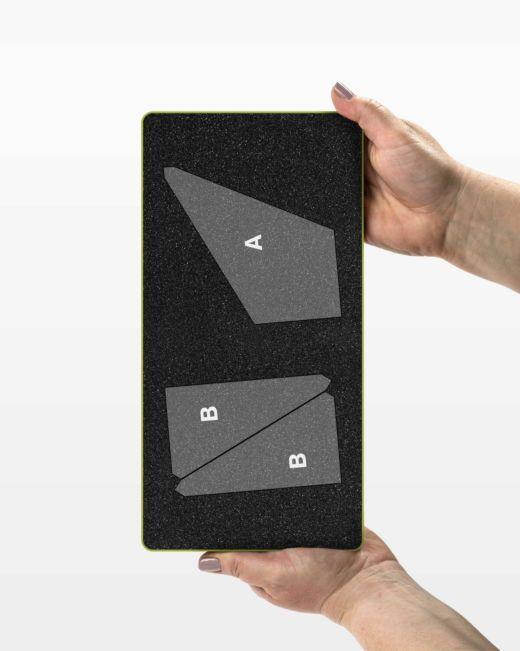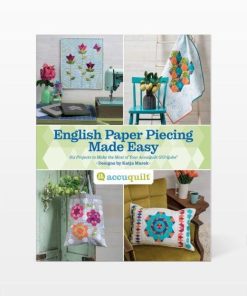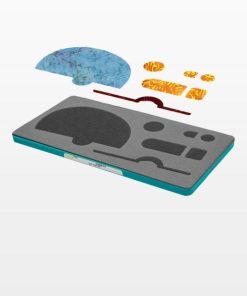GO! Kite – 4” Finished (#55254) AccuQuilt
$ 74,99 $ 37,49
Get ready to meet one of your new favorite dies! The GO! Kite helps your piece 4″ units that can be combined to create an 8″ finished block. This gives you lots of creative license in arranging the units for tons of layout options.
How to Die Cut 2-Color Kite Quilt Blocks:
For best cutting results, position fabric on the lengthwise grain (straight of grain) as it goes under the roller. Cover shape A with four layers of one fabric color and shape B with four layers of a contrasting fabric color and cut.
- Kite-Center:Â Cut a 5″ strip across the width of fabric. Fanfold into 5″ widths. Place on selected blade and cut. Cut 8 kite centers across the width of fabric. One yard of 40″ wide fabric cuts 56 kite centers.Â
- Kite-Sides:Â Cut a 3 1/2″ strip across the width of fabric. Fanfold into 5 1/8″ widths. Place on selected blade and cut. Cut 14 kite sides across the width of fabric. One yard of 40″ wide fabric cuts 140 kite sides.
Why Quilters Love the GO! Kite Die:
- Kite is a Block on Board® (BOB®) die which means it’s specially designed to cut one 2-color (or more), 8″ block in one pass through the cutter.Â
- No templates! No special rulers! Kite includes two unique shapes that are difficult to cut by hand.Â
- Kite features specialized dog-ears and includes 1/4″ seam allowances for easy alignment and piecing.Â
- Kite includes screen printed letters on die for easier piecing and organization of shapes.Â
- Free pattern downloads and step-by-step block assembly instructions are available to get you started.Â
- Charm Square-friendly.
AccuQuilt Benefits:Â
- Cut so much more fabric in less time.Â
- Get accurate cuts every time — No slipping rulers or mistakes
- Easiest to use — Simply place die on cutter, then fabric and cutting mat on top
- Save fabric with Two Tone Foam — Get more out of your fabric by placing it only over the shape you want to cut.Â
- Safe to use — No blades come anywhere near your fingers
Die Tips:Â
- With some fabrics, after cutting, a thread or two will remain where die blades meet. Snip threads with scissors.Â
- Blades on some dies are positioned at an angle. Align fabric to edge of shape, not edge of die board.Â
- Use good quality fabric to reduce fabric stretch.Â
- It’s always a good idea to test cut one shape before cutting many shapes to ensure fabric orientation is correct.Â
Fast Shipping and Professional Packing
Thanks to our longstanding association with UPS FedEx DHL and other leading international carriers, we are able to provide various shipping options. Our warehouse employees will pack every item to our exacting specifications. Your goods will go through an exhaustive inspection and securely secured prior to being delivered. We ship to thousands clients each day across multiple countries. This shows our commitment to be the largest online retailer in the world. Warehouses and distribution centers are located in Europe and the USA.
Orders with more than 1 item are assigned processing times for each item.
Before shipment, all ordered items will be thoroughly examined. Most orders today are shipped in 48 hours. The delivery estimate is between 3-7 days.
Returns
The inventory is constantly changing and we cannot control it completely because several parties are involved, including our factory and warehouse. The stock can change at any time. Be aware that your order will run out of stocks when you have placed the order.
Our policy is valid for 30 days. We will not return or exchange your purchase after 30 days from the date of purchase.
In order to be eligible for a refund your product must be unopened and in the same condition as when you received it. The item must be returned in its original packaging.
Related products
AccuQuilt Cutting Die
AccuQuilt Cutting Die
GO! Blazing Star – 6” Finished by Eleanor Burns (#55051) AccuQuilt
AccuQuilt Cutting Die
AccuQuilt Cutting Die
AccuQuilt Cutting Die
AccuQuilt Cutting Die
AccuQuilt Cutting Die
GO! Bowties – 4″ Finished by Alex Anderson Die (#55413) – Discontinued AccuQuilt
AccuQuilt Cutting Die
GO! Big Double Wedding Ring – 12 1/2” Finished (#55258) AccuQuilt
AccuQuilt Cutting Die
AccuQuilt Cutting Die
AccuQuilt Cutting Die
AccuQuilt Cutting Die
AccuQuilt Cutting Die
AccuQuilt Cutting Die
AccuQuilt Cutting Die
GO! Carefree Alphabet Uppercase Set (2 – Die Set) (#55092) AccuQuilt
AccuQuilt Cutting Die
AccuQuilt Accessories
AccuQuilt Books and CDs
English Paper Piecing Made Easy Pattern Book by Katja Marek (#55188) AccuQuilt
AccuQuilt Cutting Die
AccuQuilt Cutting Die
AccuQuilt Cutting Die
AccuQuilt Cutting Die
AccuQuilt Cutting Die
AccuQuilt Cutting Die
AccuQuilt Cutting Die
AccuQuilt Cutting Die
AccuQuilt Cutting Die
AccuQuilt Cutting Die
AccuQuilt Cutting Die
GO! Circle – 1 1/2″, 1 3/4″, 2 1/4″, 2 1/2″ (#55155) AccuQuilt
AccuQuilt Cutting Die
AccuQuilt Cutting Die
AccuQuilt Fabric Cutters
GO! Big® Electric Fabric Cutter Starter Set (#55500) AccuQuilt




































